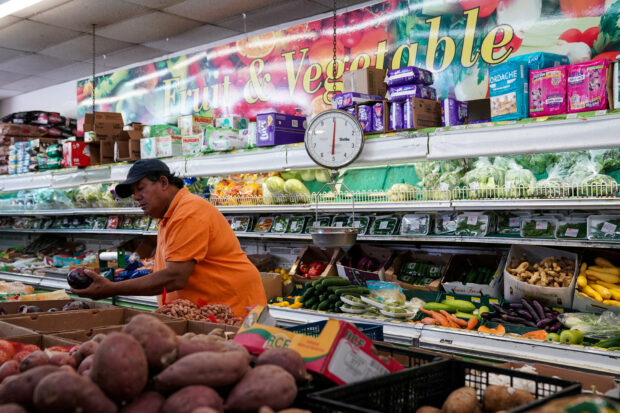
A man shops for produce at Best World Supermarket in the Mount Pleasant neighborhood of Washington, D.C., U.S., Aug 19, 2022. REUTERS/Sarah Silbiger/File photo
WASHINGTON -U.S. consumer prices rose more than expected in January amid a surge in the cost of shelter, but the pick-up in inflation did not change expectations that the Federal Reserve will start cutting interest rates in the first half of this year.
The largest increase in prices in four months reported by the Labor Department on Tuesday came against the backdrop of labor market strength and economic resilience. Some economists also blamed difficulties adjusting the data for seasonal fluctuations for the stronger-than-expected inflation readings.
“Today’s data is not what markets or the Fed would have liked to see, but it’s important not to over react and jump to the assumption that an inflationary resurgence is developing,” said Seema Shah, chief global strategist at Principal Asset Management.
“A March cut is completely off the agenda, but May could still be in play if economic activity plays ball and finally starts to show the impact from prior Fed tightening.”
READ: US Fed holds key rate steady as Powell says March cut unlikely
The consumer price index (CPI) increased 0.3 percent last month after gaining 0.2 percent in December, the Labor Department’s Bureau of Labor Statistics said. Shelter, which includes rents, accounted for more than two-thirds of the rise in the CPI.
Housing share rising
New weights, published last week, which saw the housing share rising and that of new and used cars lowered, were used to calculate the January consumer price data.
Companies also push through price increases at the start of the year, which was evident in strong rises in the costs of medical care services and tobacco products.
Food prices rose 0.4 percent. Grocery food inflation also increased 0.4 percent, boosted by more expensive sugar and sweets as well as fats and oils. Prices for nonalcoholic beverages shot up 1.2 percent, while the cost of fruits and vegetables rose 0.4 percent. But cereals and bakery products were cheaper. Prices for meat, eggs and fish were unchanged. Gasoline prices dropped 3.3 percent.
In the 12 months through January, the CPI increased 3.1 percent after advancing 3.4 percent in December.
Economists polled by Reuters had forecast the CPI gaining 0.2 percent on the month and rising 2.9 percent year-on-year. The annual increase in consumer prices has moderated from a peak of 9.1 percent in June 2022.
Annual revisions to the CPI data published last Friday were mixed, but generally showed inflation was on a downward trend after surging in 2022. The BLS updated the seasonal factors, the model it uses to strip out seasonal fluctuations from the data.
READ: Mixed US consumer price revisions leave slowing inflation trend intact
Financial markets pushed back their interest rate cut expectations to June from in May on the CPI report. U.S. stocks opened lower. The dollar rose against a basket of currencies. U.S. Treasury prices fell
Strong core inflation
Policymakers have said they are in no hurry to start lowering borrowing costs and want convincing evidence that inflation is on a sustained slow path. Since March 2022, the U.S. central bank has raised its policy rate by 525 basis points to the current 5.25% to 5.50% range.
Excluding the volatile food and energy components, the CPI rose 0.4 percent last month after increasing 0.3 percent in December. The so-called core CPI was lifted by a 0.6 percent surge in shelter after gaining 0.4 percent in December.
Owners’ equivalent rent (OER), a measure of the amount homeowners would pay to rent or would earn from renting their property, jumped 0.6 percent after rising 0.4 percent in the prior month.
Rental inflation has remained elevated despite anecdotal evidence suggesting that rent asking prices were going down. Rent measures in the CPI tend to lag the independent gauges by several months. There is also a large stock of apartment buildings in the pipeline, adding to economists’ expectations that rents will lead inflation lower this year.
While OER’s slightly bigger share in the CPI basket compared to 2023 likely pushed up inflation in January, it is expected to contribute to lower readings this year, if the BLS rent measures start to align with the private gauges, as expected.
Risks remain
There were also increases in the cost of lodging away from home. Motor vehicle insurance prices rose 1.4 percent. The cost of recreation increased as did those of communication, personal care, airline fares and education. But used car and truck prices dropped 3.4 percent. Apparel was cheaper and Americans also paid less for prescription medication.
The core CPI advanced 3.9 percent year-on-year in January, matching December’s increase.
While significant progress has been made in lowering inflation, risks remain, including the potential for renewed supply chain problems due to Red Sea shipping disruptions and drought in the Panama Canal.
Though consumer prices remain elevated, measures tracked by the Fed’s for its 2 percent inflation target have improved considerably. The increase in the personal consumption expenditures (PCE) price index slowed to an annualized rate of 1.7 percent in the fourth quarter from a 2.6 percent pace in the July-September quarter. The core PCE price index rose at a 2 percent rate, unchanged from the third quarter.